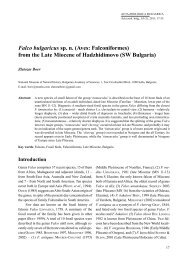Gyps bochenskii sp. n. (Aves: Falconiformes) from the Late ... - ecodb
Gyps bochenskii sp. n. (Aves: Falconiformes) from the Late ... - ecodb
Gyps bochenskii sp. n. (Aves: Falconiformes) from the Late ... - ecodb
Create successful ePaper yourself
Turn your PDF publications into a flip-book with our unique Google optimized e-Paper software.
Boev Z.<br />
d<br />
14<br />
13<br />
12<br />
11<br />
10<br />
9<br />
8<br />
7<br />
6<br />
5<br />
<strong>Gyps</strong> <strong>bochenskii</strong> <strong>sp</strong>.n.<br />
Sarcogyps calvus<br />
Torgos tracheliotus<br />
Aegypius monachus<br />
<strong>Gyps</strong> bengalensis<br />
<strong>Gyps</strong> africanus<br />
<strong>Gyps</strong> rueppellii<br />
<strong>Gyps</strong> fulvus<br />
<strong>Gyps</strong> copro<strong>the</strong>res<br />
Necrosyrtes monachus<br />
Trigonoceps occipitalis<br />
Gypohierax angolensis<br />
Gypaetus barbatus<br />
Haliaeetus albicilla<br />
4<br />
b<br />
4 5 6 7 8 9 10 11 12 13 14 15<br />
Fig. 5. Correlation between <strong>the</strong> width and height [mm] of rostrum sterni (measurements ‘b’ and ‘d’, Table 2) in <strong>the</strong> Old<br />
World vultures.<br />
cranial view; copro<strong>the</strong>res by <strong>the</strong> shape of proc.<br />
acrocoracoideus, but differs by larger dimensions;<br />
africanus by general morphology but differs by more<br />
protuberant f. a. clavicularis.<br />
Coracoid dex., pars sternalis NMNHS 247<br />
Measurements: Table 4, Fig. 4 D.<br />
Comparison: NMNHS 247 differs <strong>from</strong> Aquila<br />
chrysaetos, Haliaaetus <strong>sp</strong>p. and o<strong>the</strong>r larger <strong>sp</strong>ecies<br />
of Aquilinae by larger size. The find differs <strong>from</strong>:<br />
Sarcogyps by its lesser concavity of impressio m.<br />
sternocoracoidei, and <strong>the</strong> larger size; Aegypius by <strong>the</strong><br />
additional thickened part in <strong>the</strong> sternal part of <strong>the</strong> bone<br />
(suggesting that <strong>the</strong> griffon vulture <strong>from</strong> Varshets was<br />
more powerful than A. monachus, but it could also<br />
be due <strong>the</strong> of individual variability); Necrosyrtes both<br />
in morphology and by <strong>the</strong> considerable diference in<br />
size; Gypaetus by <strong>the</strong> much narrower f. a. sternalis<br />
and <strong>the</strong> longer f. a. sternalis; Trigonoceps by <strong>the</strong> larger<br />
general size; and Torgos by <strong>the</strong> lesser concavity of its<br />
impressio m. sternocoracoidei.<br />
The find <strong>from</strong> Varshets resembles <strong>Gyps</strong>:<br />
bengalensis in <strong>the</strong> presence of an additional thickened<br />
part in <strong>the</strong> sternal part, and general larger size;<br />
rueppellii also by presence of additional thickened<br />
part in <strong>the</strong> sternal part, besides its better development<br />
in NMNHS 246; fulvus in most of <strong>the</strong> morphological<br />
features; africanus by general morphology; and<br />
copro<strong>the</strong>res differs by larger dimensions. The<br />
additional thickened part on <strong>the</strong> cranial surface of<br />
<strong>the</strong> sternal part of diaphysis of <strong>the</strong> coracoid occurs<br />
in all 10 studied <strong>sp</strong>ecimens of genus <strong>Gyps</strong>, except<br />
one – G. fulvus BMNH 1845.1.12.4. The arc of f.<br />
articular sternalis in ventral view in <strong>the</strong> <strong>sp</strong>ecimen<br />
of Varshets is considerably more open, indicating it<br />
size was larger than in all recent <strong>sp</strong>ecies of <strong>Gyps</strong>.<br />
Phalanx dist. dig. majoris sin., NMNHS 160<br />
234





